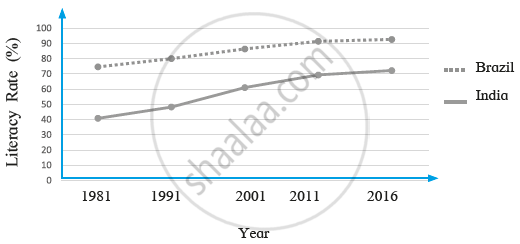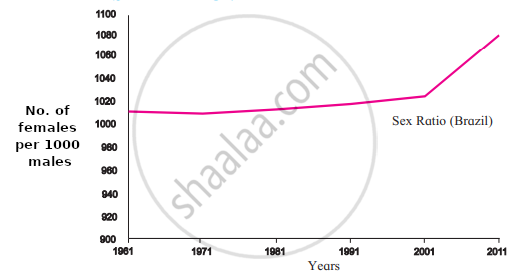Advertisements
Advertisements
Question
Observe the following graph and answer the questions given below-
Brazil- % of population (2016)

- Which type of graph is this?
- Which age group has the highest population?
- Write class interval of age groups given on Y-axis.
- Whose number is more in males and females of age above 60?
- How much percent of females are found in age group of 55 to 59 years?
- After which age group is the decrease in population found?
Solution
- This is population pyramid which shows age and sex of population.
- The age group of 30 to 34 years has the highest population.
- The class interval of age groups given on ‘Y’ axis is 5 years.
- In the age group of above 60 years, the number of females is more than males.
- In the age group of 55 to 59 years, females are more than 2%.
- The decrease in population is found after the age group of 30-34.
APPEARS IN
RELATED QUESTIONS
Answer the following in detail.
Explain - The growth rate of population in India is decreasing but population is increasing.
The average life expectancy in India is increasing.
Identify the wrong pair.
State and population density
i) Sao Paulo – Dense
ii) Himachal Pradesh – dense
iii) Amazonas – Sparse
iv) West Bengal – Dense
Read the following graph and answer the questions
India and Brazil Literacy Rate (%)

i) What was the literacy rate in Brazil in 2001?
ii) In which decade did the literacy rate increase the most in India?
iii) What is the difference between the literacy rates of India and Brazil in 1991?
iv) By how much has the literacy rate increased in India between 1981- 2016?
v) How much is the interval generally used in the graph?
vi) What conclusions can you draw from the graph regarding the literacy rates of India and Brazil?
With the help of given statistical data prepare a simple bar graph and answer the following questions:
India – Trend of Urbanisation (1961-2011)
| Year | Percentage of Urban Population |
| 1961 | 18.0 |
| 1971 | 18.2 |
| 1981 | 23.3 |
| 1991 | 25.7 |
| 2001 | 27.8 |
| 2011 | 31.2 |
(1) What is the interval of the data?
(2) Which decade shows slow rate of urbanisation?
(3) Which decade shows high rate of urbanisation?
Is the following sentence right or wrong? Correct the wrong one.
The life expectancy of Indians is decreasing.
- Compare and classify the population densities shown in the squares ‘a’ and
‘b’ representing 1 sq.km of area. - If in figure B, one sign = 100, then what will be the sex ratio?
(a)
(b)
Expectancy of life is still less in developing countries.
Observe the following graph and answer the questions given below:


- What does the sex ratio of India indicate ?
- Since when has the sex ratio in India increased?
- What was the condition of sex ratio in India in 1961-71?
- What does sex ratio mean?
- What does the sex ratio of Brazil indicate?
- In which year did the women outnumber men in considerable amount in Brazil?
If the proportion of dependent age groups increases in the composition of population, how will it affect the economy of a country?
